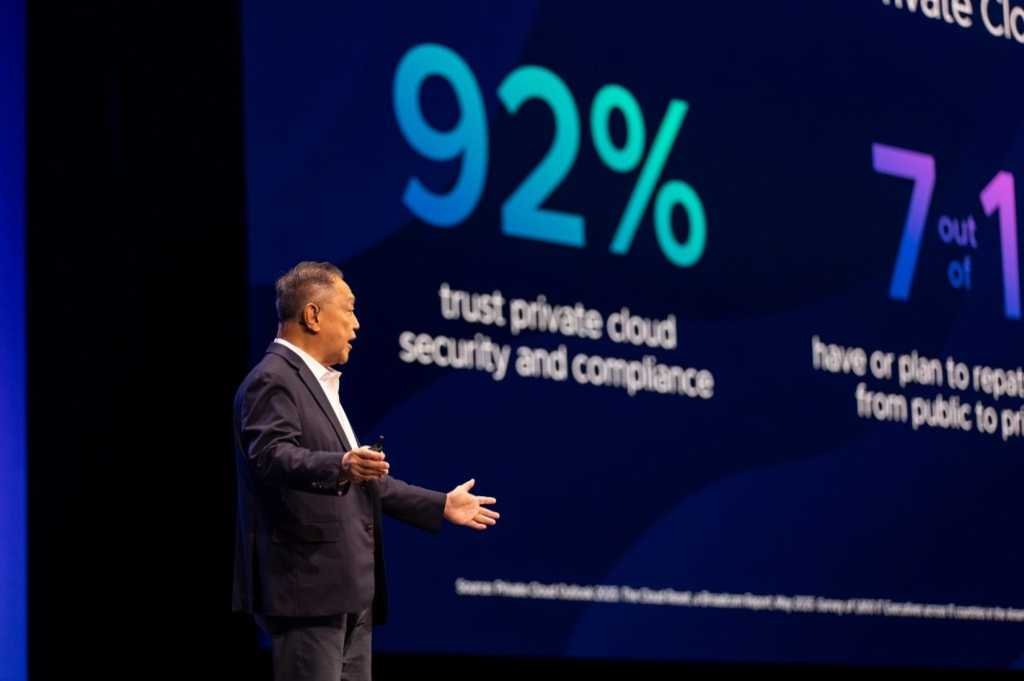AI Insights
Broadcom touts AI-native VMware, but gains aren’t revolutionary

“We have the relationships,” Umesh Mahajan, Broadcom’s general manager for application networking and security, told Network World. A large organization can’t simply stop using VMware, he says. “These workloads can’t disappear overnight. So, we will continue to have those relationships.”
In addition, VMware’s technology is proprietary, complicated, and not something a startup can easily clone, Prashant Gandhi, the company’s vice president of products, told Network World.
“You have to have scale,” Gandhi said. “You have to have robustness, you have to operationalize your enterprise workflows and security policies. All of that is not replicable for the next five, seven, ten years.”
A company isn’t going to want to build its own virtualization technology from scratch, either, said Mahajan, even if agentic AI does make it easier to build new software. “The CEO or CFO is focused on their core business, not on building all kinds of infrastructure.”
“You don’t want to go to some startup unless it’s really revolutionary, but that’s unlikely because we have engineering and technology teams, and we see what is happening in the market, and we’ll adapt,” Mahajan added. He didn’t provide any examples of anything new or revolutionary that VMware was working on in relation to its core platform.
Here are the top announcements from the event:
AI Insights
We’re Entering a New Phase of AI in Schools. How Are States Responding?

Artificial intelligence topped the list of state technology officials’ priorities for the first time, according to an annual survey released by the State Educational Technology Directors’ Association on Wednesday.
More than a quarter of respondents—26%—listed AI as their most pressing issue, compared to 18% in a similar survey conducted by SETDA last year. AI supplanted cybersecurity, which state leaders previously identified as their No. 1 concern.
About 1 in 5 state technology officials—21%—named cybersecurity as their highest priority, and 18% identified professional development and technology support for instruction as their top issues.
Forty percent of respondents reported that their state had issued guidance on AI. That’s a considerable increase from just two years ago, when only 2% of respondents to the same survey reported their state had released AI guidance.
State officials’ heightened attention on AI suggests that even though many more states have released some sort of AI guidance in the past year or two, officials still see a lot left on their to-do lists when it comes to supporting districts in improving students’ AI literacy, offering professional development about AI for educators, and crafting policies around cheating and proper AI use.
“A lot of guidance has come out, but now the rubber’s hitting the road in terms of implementation and integration,” said Julia Fallon, SETDA’s executive director, in an interview.
SETDA, along with Whiteboard Advisors, surveyed state education leaders—including ed-tech directors, chief information officers, and state chiefs—receiving more than 75 responses across 47 states. It conducted interviews with state ed-tech teams in Alabama, Delaware, Nebraska, and Utah and did group interviews with ed-tech leaders from 14 states.
AI professional development is a rising priority
States are taking a myriad of approaches to responding to the AI challenge, the report noted.
Some states—such as North Carolina and Utah—designated an AI point person to help support districts in puzzling through the technology. For instance, Matt Winters, who leads Utah’s work, has helped negotiate statewide pricing for AI-powered ed-tech tools and worked with an outside organization to train 4,500 teachers on AI, according to the report.
Wyoming, meanwhile, has developed an “innovator” network that pays teachers to offer AI professional development to colleagues across the state. Washington hosted two statewide AI summits to help district and school leaders explore the technology.
And North Carolina and Virginia have used state-level competitive grant programs to support activities such as AI-specific professional development or AI-infused teaching and learning initiatives.
“As AI continues to evolve, developing connections with those in tech, in industry, and in commerce, as well as with other educators, will become more important than ever,” wrote Sydnee Dickson, formerly Utah’s state superintendent of public instruction, in an introduction to the report. “The technology is advancing too quickly for any one person or state to have all the answers.”
AI Insights
General-purpose LLMs can be used to track true critical findings

General-purpose large language models (LLMs), such as GPT-4, can be adapted to detect and categorize multiple critical findings within individual radiology reports, using minimal data annotation, researchers have reported.
A team led by Ish Talati, MD, of Stanford University, with colleagues from the Arizona Advanced AI and Innovation (A3I) Hub and Mayo Clinic Arizona, retrospectively evaluated two “out-of-the-box” LLMs — GPT-4 and Mistral-7B — to see how well they might perform at classifying findings indicating medical emergency or requiring immediate action, among others. Their results were published on September 10 in the American Journal of Roentgenology.
Timely critical findings communication can be challenging due to the increasing complexity and volume of radiology reports, the authors noted. “Workflow pressures highlight the need for automated tools to assist in critical findings’ systematic identification and categorization,” they said.
The study demonstrated that few-shot prompting, incorporating a small number of examples for model guidance, can aid general-purpose LLMs in adapting to the medical task of complex categorization of findings into distinct actionable categories.
To that end, Talati and colleagues evaluated GPT-4 and Mistral-7B on more than 400 radiology reports selected from the MIMIC-III database of deidentified health data from patients in the intensive care unit (ICU) at Beth Israel Deaconess Medical Center from 2001 to 2012.
Analysis included 252 radiology reports of varying modalities (56% CT, ~30% radiography, 9% MRI, for example) and anatomic regions (mostly chest, pelvis, and head).
The reports were divided into a prompt engineering tuning set of 50, a holdout test set of 125, and a pool of 77 remaining reports used as examples for few-shot prompting. An external test set consisted of 180 chest x-ray reports extracted from the CheXpert Plus database.
With a board-certified radiologist and software separately, manual reviews of the reports classified them at consensus into one of three categories:
- True critical finding (new, worsening, or increasing in severity since prior imaging)
- Known/expected critical finding (a critical finding that is known and unchanged, improving, or decreasing in severity since prior imaging)
- Equivocal critical finding (an observation that is suspicious for a critical finding but that is not definitively present based on the report)
The models analyzed the submitted report and provided structured output containing multiple fields, listing model-identified critical findings within each of the three categories, according to the group. Evaluation included automated text similarity metrics (BLEU-1, ROUGE-F1, G-Eval) and manual performance metrics (precision, recall) in the three categories.
|
Precision and recall comparison for LLMs tracking true critical findings |
||
|
Type of test set and classification |
GPT-4 |
Mistral-7B |
|
Precision |
||
| Holdout test set, true critical findings |
90.1% |
75.6% |
| Holdout test set, known/expected critical findings |
80.9% |
34.1% |
| Holdout test set, equivocal critical findings |
80.5% |
41.3% |
| External test set, True critical findings |
82.6% |
75% |
| External test set, known/expected critical findings |
76.9% |
33.3% |
| External test set, equivocal critical findings |
70.8% |
34% |
|
Recall |
||
| Holdout test set, true critical findings |
86.9% |
77.4% |
| Holdout test set, known/expected critical findings |
85% |
70% |
| Holdout test set, equivocal critical findings |
94.3% |
74.3% |
| External test set, True critical findings |
98.3% |
93.1% |
| External test set, known/expected critical findings |
71.4% |
92.9% |
| External test set, equivocal critical findings |
85% |
80% |
“GPT-4, when optimized with just a small number of in-context examples, may offer new capabilities compared to prior approaches in terms of nuanced context-dependent classifications,” Tatali and colleagues wrote. “This capability is crucial in radiology, where identification of findings warranting referring clinician alerts requires differentiation of whether the finding is new or already known.”
Though promising, further refinement is needed before clinical implementation, the group noted. In addition, the group highlighted a role for electronic health record (EHR) integration to inform more nuanced categorization in future implementations.
Furthermore, additional technical development remains required before potential real-world applications, the group said.
See all metrics and the complete paper here.
AI Insights
The AI Trade Picks Up Steam After Oracle’s ‘Truly Historic’ Quarter

Key Takeaways
- Cloud computing and software provider Oracle on Tuesday reported its backlog grew to $455 billion last quarter, a 359% increase from the prior year.
- The company’s pipeline signaled artificial intelligence spending should remain strong for several years, sending Oracle shares sharply higher and boosting the majority of AI stocks.
- Wall Street analysts expressed shock on Oracle’s earnings call Tuesday, with one calling the company’s growth forecasts “truly historic.”
The artificial intelligence trade got a shot of adrenaline on Wednesday after results from database software and cloud provider Oracle suggested the AI spending bonanza has ample room to run.
Oracle (ORCL) on Tuesday reported its backlog swelled to $455 billion, a 359% year-over-year increase, after it signed four multibillion-dollar cloud deals in the first quarter of its 2026 fiscal year. Executives said the backlog is expected to surpass half a trillion as Oracle inks more big deals in the coming months.
Oracle also forecast cloud revenue would grow from an estimated $18 billion this fiscal year to $144 billion in 2030, about $50 billion more than Wall Street had forecast. Oracle said most of that revenue forecast was already reflected in its backlog, giving some investors greater confidence in the numbers. Meanwhile, the Wall Street Journal reported Wednesday that Oracle had signed a five-year contract worth $300 billion with ChatGPT creator OpenAI.
Oracle’s projections completely overshadowed lackluster first-quarter results, and sent its shares soaring as much as 43% on Wednesday.
The rising tide of robust AI spending was lifting plenty of boats on Wednesday. Shares of AI chip giants Nvidia (NVDA) and Broadcom (AVGO) were recently up more than 4% and 9%, respectively, while chip design company Arm Holdings (ARM) surged more than 8%. The PHLX Semiconductor Index (SOX) was up about 2%. Data center infrastructure provider Vertiv Holdings (VRT) jumped about 9%, while power generators Vistra (VST) and Constellation Energy (CEG) advanced 8% and 6%, respectively.
Oracle’s major cloud competitors were the only drag on the AI trade on Wednesday. Amazon (AMZN) declined more than 3%, while Meta Platforms (META) dropped nearly 2%. Alphabet (GOOG) and Microsoft (MSFT) ticked higher.
Wall Street Hails ‘Momentous’ Quarter
Wall Street’s ebullience over the results was first visible on Oracle’s earnings call Tuesday night.
“Even I’m sort of blown away by what this looks like going forward,” said Guggenheim analyst John DiFucci at the top of the question and answer portion of the call. “I tell my team, ‘Pay attention to this’—even those that are not working on Oracle—‘because this is a career event happening right now,” DiFucci added.
“There’s no better evidence of a seismic shift happening in computing than these results that you just put up,” said Deutsche Bank analyst Brad Zelnick. Others called the quarter “momentous” and the backlog growth “truly historic.”
AI Demand, Investments Expected To Remain Strong
AI investments have been driven by what many have characterized as insatiable demand for training and inference, and Oracle’s results appeared to support that assessment.
On Oracle’s earnings call, co-founder and chair Larry Ellison said an unnamed company had requested all of Oracle’s available inferencing capacity. “I’d never gotten a call like that,” Ellison said.
Big Tech’s investment in capacity to meet that demand is expected to remain robust in the coming years, supported by healthy cash flows at the biggest cloud providers and supportive tax incentives.
Cloud providers like Microsoft, Alphabet and Amazon have been key drivers of the AI infrastructure trade in recent years. Hyperscalers are expected to spend a cumulative $368 billion on infrastructure this year, with much of that earmarked for data centers and the chips and servers that fill them, according to Goldman Sachs.
Oracle on Tuesday forecast capital expenditures of $35 billion in the 12 months through May 2026, about $10 billion more than the figure executives gave as a minimum last quarter.
Tax incentives written into the recently passed One Big Beautiful Bill Act should also support AI infrastructure investment. Morgan Stanley expects the bill’s immediate capital investment depreciation provisions to boost Big Tech’s free cash flows by nearly $50 billion this year. The firm expects a sizable portion of those tax savings to be spent on AI infrastructure.
-

 Business2 weeks ago
Business2 weeks agoThe Guardian view on Trump and the Fed: independence is no substitute for accountability | Editorial
-
Tools & Platforms4 weeks ago
Building Trust in Military AI Starts with Opening the Black Box – War on the Rocks
-

 Ethics & Policy2 months ago
Ethics & Policy2 months agoSDAIA Supports Saudi Arabia’s Leadership in Shaping Global AI Ethics, Policy, and Research – وكالة الأنباء السعودية
-

 Events & Conferences4 months ago
Events & Conferences4 months agoJourney to 1000 models: Scaling Instagram’s recommendation system
-

 Jobs & Careers2 months ago
Jobs & Careers2 months agoMumbai-based Perplexity Alternative Has 60k+ Users Without Funding
-

 Education2 months ago
Education2 months agoMacron says UK and France have duty to tackle illegal migration ‘with humanity, solidarity and firmness’ – UK politics live | Politics
-

 Education2 months ago
Education2 months agoVEX Robotics launches AI-powered classroom robotics system
-

 Podcasts & Talks2 months ago
Podcasts & Talks2 months agoHappy 4th of July! 🎆 Made with Veo 3 in Gemini
-

 Funding & Business2 months ago
Funding & Business2 months agoKayak and Expedia race to build AI travel agents that turn social posts into itineraries
-

 Podcasts & Talks2 months ago
Podcasts & Talks2 months agoOpenAI 🤝 @teamganassi

